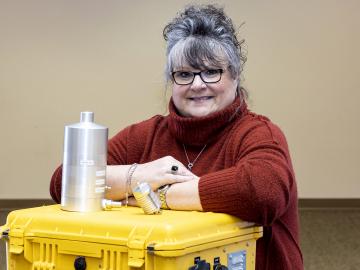
Filter News
Area of Research
- Advanced Manufacturing (8)
- Biology and Environment (37)
- Building Technologies (1)
- Clean Energy (70)
- Computational Biology (1)
- Computational Engineering (2)
- Computer Science (4)
- Electricity and Smart Grid (1)
- Fusion and Fission (15)
- Fusion Energy (1)
- Isotopes (13)
- Materials (17)
- Materials for Computing (18)
- Mathematics (1)
- National Security (9)
- Neutron Science (17)
- Nuclear Science and Technology (1)
- Quantum information Science (3)
- Sensors and Controls (1)
- Supercomputing (21)
- Transportation Systems (1)
Date
News Topics
- 3-D Printing/Advanced Manufacturing (36)
- Advanced Reactors (5)
- Artificial Intelligence (29)
- Big Data (13)
- Bioenergy (23)
- Biology (34)
- Biomedical (15)
- Biotechnology (10)
- Buildings (26)
- Chemical Sciences (19)
- Clean Water (11)
- Climate Change (30)
- Composites (10)
- Computer Science (48)
- Coronavirus (10)
- Critical Materials (7)
- Cybersecurity (5)
- Decarbonization (27)
- Education (1)
- Emergency (1)
- Energy Storage (30)
- Environment (57)
- Exascale Computing (7)
- Fossil Energy (2)
- Frontier (10)
- Fusion (12)
- Grid (17)
- High-Performance Computing (32)
- Isotopes (23)
- ITER (5)
- Machine Learning (9)
- Materials (45)
- Materials Science (35)
- Mathematics (3)
- Mercury (3)
- Microscopy (12)
- Nanotechnology (12)
- National Security (20)
- Net Zero (6)
- Neutron Science (28)
- Nuclear Energy (13)
- Partnerships (11)
- Physics (7)
- Polymers (10)
- Quantum Computing (15)
- Quantum Science (24)
- Security (5)
- Simulation (12)
- Space Exploration (7)
- Statistics (3)
- Summit (13)
- Sustainable Energy (51)
- Transportation (33)
Media Contacts

In his career focused on energy storage science, Jianlin Li has learned that discovering new ways to process and assemble batteries is just as important as the development of new materials.

From Denmark to Japan, the UK, France, and Sweden, physicist Ken Andersen has worked at neutron sources around the world. With significant contributions to neutron scattering and the scientific community, he’s now serving in his most important role yet.

Through a consortium of Department of Energy national laboratories, ORNL scientists are applying their expertise to provide solutions that enable the commercialization of emission-free hydrogen fuel cell technology for heavy-duty

Toward the goal of bringing the next generation of nuclear power reactor technology online this decade, ORNL and Analysis and Measurement Services Corporation have successfully completed loop testing of instrument and control sensors for an advanced reactor design for small modular reactors.

The U.S. Department of Energy’s Innovative and Novel Computational Impact on Theory and Experiment, or INCITE, program is seeking proposals for high-impact, computationally intensive research campaigns in a broad array of science, engineering and computer science domains.

Rich Giannone uses bioanalytical mass spectrometry to examine proteins, the primary driver in biological systems.

If a nation tries to hide a clandestine nuclear operation, Paula Cable-Dunlap and her team will give their all to help find it. Just don’t call their work “nuclear CSI” – not where she can hear, at least.

When COVID-19 was declared a pandemic in March 2020, Oak Ridge National Laboratory’s Parans Paranthaman suddenly found himself working from home like millions of others.

An analysis published in the Proceedings of the National Academy of Sciences and led by researchers from the U.S. Department of Energy’s Oak Ridge National Laboratory has received the 2021 Sustainability Science Award from the Ecological Society of America.

Oak Ridge National Laboratory scientists proved molybdenum titanium carbide, a refractory metal alloy that can withstand extreme temperature environments, can also be crack free and dense when produced with electron beam powder bed fusion.


